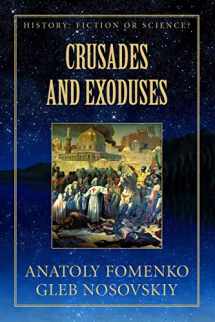
Crusades and Exoduses (History: Fiction or Science?)
ISBN-13:
9781549731013
ISBN-10:
1549731017
Author:
Anatoly Fomenko, Gleb Nosovskiy
Publication date:
2017
Publisher:
Independently published
Format:
Paperback
200 pages
Category:
European History
FREE US shipping
Book details
ISBN-13:
9781549731013
ISBN-10:
1549731017
Author:
Anatoly Fomenko, Gleb Nosovskiy
Publication date:
2017
Publisher:
Independently published
Format:
Paperback
200 pages
Category:
European History
Summary
Crusades and Exoduses (History: Fiction or Science?) (ISBN-13: 9781549731013 and ISBN-10: 1549731017), written by authors
Anatoly Fomenko, Gleb Nosovskiy, was published by Independently published in 2017.
With an overall rating of 3.9 stars, it's a notable title among other
European History
books. You can easily purchase or rent Crusades and Exoduses (History: Fiction or Science?) (Paperback) from BooksRun,
along with many other new and used
European History
books
and textbooks.
And, if you're looking to sell your copy, our current buyback offer is $0.3.
Description
Why and when the Crusades? The Christianity originated in the Byzantine Empire in XII century as Oriental Orthodox Catholic religion that went in the XII - XV centuries through the subsequent splits, mutations into the competing Orthodox, Catholic, Western, Eastern and Oriental Christianity, Mithraism, Judaism, Buddism, and Islam. Crusades of 1189-1192 AD and 1199-1204 AD to Jerusalem-Constantinople were military operations under the banner of Christianity by the followers and relatives of Jesus idem Emperor Andronicus killed during a religious mutiny. Crusades have ended with the Sack of Constantinople in 1204. Crusades provoked a counter reaction of Islam that by XIII century started to morph from an early Christian belief into a powerful religious movement, formed a Caliphate that spans from Middle Asia to Spain. Constantinople was taken by Mehmet the Conqueror in 1453, renamed Istanbul, and Byzantium became a part of the Muslim Ottoman Empire. The most probable prototype of the historical Jesus was Andronikos I Komnenos (allegedly AD 1183 to 1185), the Emperor of Byzantium, reflected in the consensual history for his numerous failed reforms; his traits and deeds reflected in ‘biographies’ of many real and imaginary persons. According to New Chronology, the New Testament is the rendition of religious events of the XIIth century AD. The historical Jesus Christ is very probably a composite figure and reflection of the Biblical prophet Elisha, Osiris, god of the death, life, and resurrection, Pope Gregory VII, Saint Basil of Caesarea, and even Li Yuanhao (“Son of Heaven”), Euclides, Dionysius, and Andronikos. The seemingly vast differences in the biographies of these figures result from a difference in languages, time and place of writing. By approx. 1200 A.D. Judaa-Izrael Empire starts to expand as an Orthodox Catholic Christendom Empire in Europe and Eurasia. Exoduses of Byzantine nobility and scholars to Europe after the sack of Constantinople formed the foundation of its future superiority. By approx. 1400 A.D. Christendom Empire transforms into the centralized “Evil Empire” of Eurasia that falls apart into independent Kingdoms of Europe and Empires of Asia by 1600 A.D. The consensual world history was manufactured in Europe in XVI-XIX centuries with political agenda of powers of that period on the basis of erroneous clerical chronology elaborated by Jesuits Scaliger and Petavius. ⦁By the middle of XVI th century the prime political agenda of Europe that reached superiority in Sciences and Technologies, but was still inferior militarily to the Evil Empire of Eurasia, was to free Europe. ⦁The concerted effort of European aristocracy, black and white Catholic clergy, Protestants, humanists and scientists in XV - XVII th centuries in creation and dissemination of fictional Ancient World served this agenda. ⦁The scientists supported the myth of Ancient World as safe cover for their heretic research that produced results contrarian to the tenets of Christianity. They justified their discoveries by authorities of ancient scientists they themselves invented and used as pseudonyms. ⦁The humanists developed and supported the myth of Ancient World as convenient cover for their ideas that conflicted with Christianity and aristocracy. They too justified their ideas on authorities of ancient authors of their own making and used as aliases. Prescient Saint Augustine warned: 'be wary of mathematicians, particularly when they speak the truth!'. Dr. Anatoly Fomenko is a Full Member (Academician) of the Russian Academy of Sciences, Full Member of the Russian Academy of Natural Sciences, Full Member of the International Higher Education Academy of Sciences, Doctor of Physics and Mathematics, Professor, Head of the Moscow State University Department of Mathematics and Mechanics.


We would LOVE it if you could help us and other readers by reviewing the book
Book review

Congratulations! We have received your book review.
{user}
{createdAt}
by {truncated_author}


